Q: Most efficient way to crush the soul of creativity?
A: Formal process.
If you work in any fast-moving industry for long enough, you’ll come to either love or despise process. It’s inevitable. We all have to work with so many people, teams, and partners on increasing complex systems and services, it’s only natural to try and impose some order to stave off potential chaos. Nothing wrong with that, in fact it’s needed for deeply technical projects.
Similarly, you’ll also see highly prescriptive process and methodology in creative pursuits. Some of it is necessary when integrating within engineering teams and projects. Some of it not. Turns out that even the most experienced and disciplined designers and creatives crave order in the face of so many moving parts. Not me.
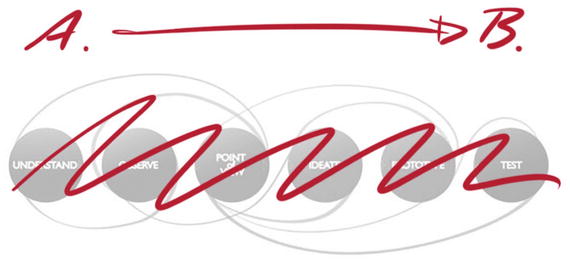
Fast Design is all about quickly moving from A to B, not adhering to process.
Fast Design avoids much of the traditional structure and step-wise process in favor of a more unstructured, common-sense approach to moving things along. Start by figuring out the optimal design or solution, think about what it would take to get there, and go. You’ll soon realize much of what you want to do is difficult given the current situation (resources, schedule, funds), but you’ll push forward quickly anyway doing the best you can in the brief time you’ve allocated to figure all this out.
You will find that Fast Design is a great way to envision holograms and other creative deliverables, but might not be the correct approach for delivering the engineering designs for the next aircraft or high-speed train you’ll be riding in. It trades off rigor for speed, correctness for doneness. Not for everyone. Not for all situations. But, perfect for envisioning breakthrough holographic experiences due to its bias toward action and output.

The envisioning flow is a suggested set of activities, not a rigid methodology
We’ll cover how this applies to envisioning holograms in detail over the next few chapters, but for now here’s a super quick overview of the different segments and a few important observations from using it to make our visions real enough to share with other people.
Ideate
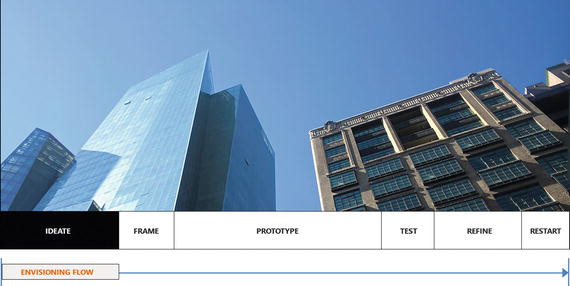
We’ve talked quite a bit about ideation , conceptualization, and just daydreaming in the first part of the book. All that’s left to say on this phase is that you should practice it as much as possible. Try to produce lots of ideas without passing any judgement on them. It really is unbounded exploration. Doing this frequently helps get fresh ideas out your head and into the world to know which genuinely resonate with others.
For example, the envisioning piece on the cover of this book was inspired by the thought that a beautiful hotel lobby doesn’t have to feel so cold just because it’s empty at the moment. Holograms could always inhabit these spaces, waiting for people to activate the space and its vibe. Lots of ideas popped into my head right after that initial thought, but some other good ones were a direct result of sitting down and ideating with paper and a pen. There were some weird ideas in that batch, like the one I ultimately decided on – a light creature moving to the beats of a live DJ being beamed into the room from afar.
People don’t have to like the ideas, understand them, or even want to experience your ideas for themselves – but, just the act of listening to their feedback will be an enormous help in deciding for yourself what to pursue. No one can tell you what’s right or wrong when it comes to envisioning, nonetheless they can let you know what makes sense to them or what seems plausible.
Frame
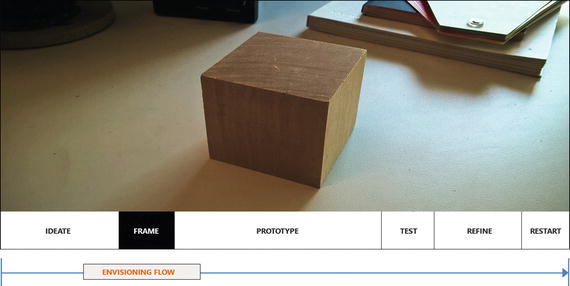
This phase is essential to doing envisioning well. Framing is not about vetting an idea as much as giving it some boundaries to explore within. You wouldn’t want to start eliminating possible outcomes at this early stage, but rather give yourself as set of guardrails to bump into along the way to contain your effort. These guardrails become a decision framework for focusing your effort down just a bit.
Continuing with the cover example, deciding early on that multiple people should be able to enjoy the warmer hotel lobby vibe at the same time established a bounding box around experience. Without that, it could have gone down the path of being intended as totally unique scenarios for each person. That type of guide may seem obvious or simple to arrive at, and it is, yet it saves a tremendous amount of wasted effort as we move toward deeply exploring the idea.
Creating a lightweight decision framework for the design helps you make a few initial choices quickly. These tend to be which scenario best illustrates the idea, what technique can help you go the fastest, and how much time you want to spend exploring all this.
Done quickly and without overthinking anything, framing can also be a very fun part of envisioning. Moving to decisions feels good. Things start snapping into place. The flow starts working and your envisioning project is off and running.
Prototype
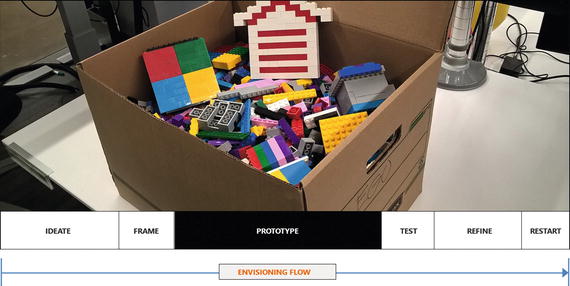
Building a prototype of your breakthrough idea is distinctly different than the creation phase. Here, the emphasis is on the detailed work of putting enough pieces together correctly so another person can try it out, or at least get the gist. It’s necessary to bring things to life as quickly as possible, so don’t try to be right all of the time, just try to be fast most the time.
As we discussed, there are many kinds of prototypes that run the gamut from it being all in your head all the way up to working code and hardware. Some will be better than others at landing the idea, but it really doesn’t matter which method you choose if you get right into it.
In this example, my choice to quickly prototype the concept of warming up a hotel lobby was to bring the dancing light creature to life through a simple code prototype so that the movement and reaction could be tested out. Rather than just animating something like this After Effects, wiring up a 3D character to move and react to ambient sound is a decent amount of work and constitutes a technical proof.
It’s been my observation over many years that people on product teams either love or can’t stand the technical prototyping phase of a project. The more technical the person, the more they like it. The more creative the person, the more soul crushing. Here’s why – this activity is all about making the hard choices required to narrow your focus and execute something concrete. Highly stimulating and gratifying to some, yet it feels more like the depths of despair for others as the optimal transforms to the doable, and the original dream is somewhat diminished.
Fortunately, turning holographic ideas into working prototypes of any sort is typically very rewarding because of its freshness and necessity to learn new things.
Test
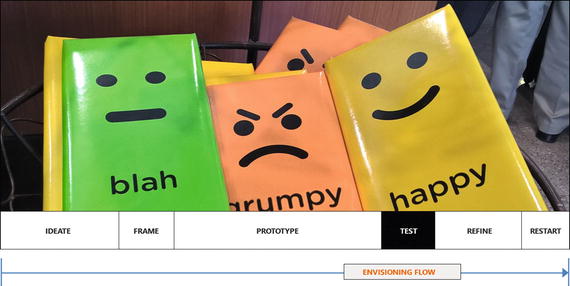
In the old days, testing a product or service meant focus groups, formal usability studies with one way mirrors, weeks of analysis, and voluminous findings. Not anymore. Testing something out has devolved to informal questioning over a latte or cornering unsuspecting people in the lobby of your building. Regardless of the method, the point is to get someone else’s thoughts and opinions on something you are invariably way too close to. People’s first takes are incredibly valuable if you truly listen and give them a chance to sink in, good or bad.
When I tested this dancing light creature with its own DJ concept out on people as an envisioned prototype, their first reaction was what anyone would have hoped for – loved it. Wanted more than I could provide in a quick prototype for sure, which led to many great suggestions for where to take it next. It occurred to me that my test was conducted with friends and coworkers who might not have wanted to hurt my feelings with a negative reaction, so I needed to consider how to get this out to a much wider audience to gage the reaction more objectively.
Don’t be afraid to go wide with your testing of holographic ideas (if you can think of way to do that well). Video comes to mind as an easy way to reach a very broad and diverse audience quickly. Open it up to comments and strap in. Chances are it’ll be a bit of a rough ride regardless of the merits, I can assure you. People love giving you constructive criticism along with praise.
Refine

In today’s world of agile development techniques and continuous releases, it seems odd to call out the need to refine our holographic ideas. We expect they will be flawed in some way (as all high-tech products are) or not land quite as nicely as we originally imagined. Refinement seems a natural part of our method, no?
No. That’s not the kind of refining were talking about here. This section should probably be called Learning, but it’s more action oriented than that sounds. After we test something and listen carefully to the feedback, we should learn from that and immediately change whatever was called out and test it again within hours or even minutes if possible. Really.
The problem with today’s approach to agile development is that it’s anything but. Truly agile means fast, which for us means now. Trust your early tester’s reactions and try out different approaches with them in lo-fi if necessary to learn quickly. Try morphing the idea or even go as far as completely pivoting if you have to.
With this example, the refinement came in the form of learning that some people won’t get into something like this live show in a hotel lobby because they’re still very self-conscious about letting go in public. Hard to not feel a bit odd when you’re the only one grooving to an invisible ten foot tall light creature and holographic DJ. Human nature sometimes trumps any good idea.
Restart
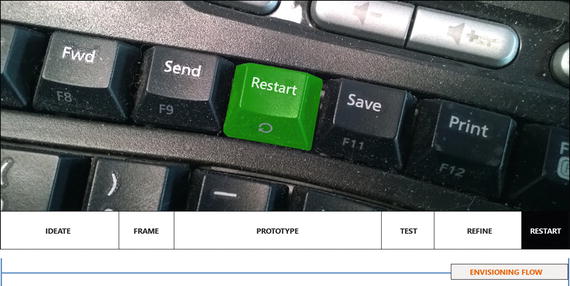
True breakthroughs are rare. They can’t be scheduled or predicted. Musicians don’t try to write a hit song every time. They just keep practicing, creating, and pushing themselves to go outside their comfort zone. That’s when the magic happens. Same applies here. Ideas are typically not perfect on the first go round. Use your gut instinct to try out something that seems radical. Restart the ideation process for no good reason. Throw everything you’ve done out. Don’t let there be any sacred artifacts that can’t be discarded for the sake of moving the project forward.
The cover idea turned out to be a great example of working the envisioning process and letting it take you where you need to push and explore. I would not have thought about using a particular shader technique for the visual appearance of the light creature without collaborating with a coworker on this. Being able to inject your own music was always part of the idea, but I needed to see that people could also enjoy someone else’s playlist just as much before letting that idea go. Restarting the project as more of a concert experience rather than interactive playlist jam was something I originally would have thought to be limiting, but turned out to be the better choice.
Don’t be afraid to restart the whole process and do it differently next time. At the same time, you can choose to not restart and press on. Either way, you’ll find that envisioning will change your normal method of approaching creation and development of ideas.
Let’s Go!
Now that you’ve had a quick look at the way we’ll be envisioning it’s time to get started. Try to pick an idea you want to bring to life and turn the page to dig in and break through.
